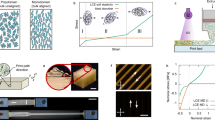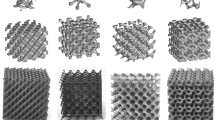Abstract
Polymers are widely used as damping materials in vibration and impact applications. Liquid crystal elastomers (LCEs) are a unique class of polymers that may offer the potential for enhanced energy absorption capacity under impact conditions over conventional polymers due to their ability to align the nematic phase during loading. Being a relatively new material, the high rate compressive properties of LCEs have been minimally studied. Here, we investigated the high strain rate compression behavior of different solid LCEs, including cast polydomain and 3D-printed, preferentially oriented monodomain samples. Direct ink write (DIW) 3D printed samples allow unique sample designs, namely, a specific orientation of mesogens with respect to the loading direction. Loading the sample in different orientations can induce mesogen rotation during mechanical loading and subsequently different stress-strain responses under impact. We also used a reference polymer, bisphenol-A (BPA) cross-linked resin, to contrast LCE behavior with conventional elastomer behavior.
Access provided by Autonomous University of Puebla. Download conference paper PDF
Similar content being viewed by others
Keywords
6.1 Introduction
Polymers are a broad class of materials regularly used in the protection of valuable assets from mechanical insults such as impact or vibration. Polymers are often manufactured in a foamed state, which allows energy absorption of the material via induced changes in the mesostructure. The mechanical performance of polymer foams can be further enhanced through careful selection of the base polymer to allow energy dissipation from both microstructure and mesostructure effects. Many widely used polymers have amorphous microstructure and isotropic material behavior.
Liquid crystal elastomers (LCE) may offer enhanced strain-rate-dependent impact absorbing capability due to their ability to undergo an alignment phase transition, wherein the nematic liquid crystal domains are oriented during finite straining. This alignment phase transition has the potential to offer a new energy dissipation mechanism for shock and vibration applications compared to standard polymers. LCE lattices have been shown to exhibit such dissipative mechanical properties in the vibratory loading regime (dynamic mechanical analysis) [1] and in drop tests [2] compared to conventional polymer lattices. Advances in 3D printing technology have allowed the printing of LCEs with different mesogen orientations and, by extension, differences in mechanical response for this unique class of polymer. Yet, the behavior of LCEs has not been studied in detail at elevated strain rates in compression.
In this investigation, we studied the mechanical behavior of solid LCEs and a reference polymer, bisphenol-A (BPA), at high strain rates. Both materials have glass transition temperatures near 0 °C and have similar storage moduli near 80 °C, where the LCE is well above its nematic-to-isotropic transition temperature (about 45 °C). At room temperature, the LCE materials are in their nematic state and exhibit the enhanced dissipation behavior seen in standard dynamic mechanical analysis data [3]. Direct ink write (DIW) 3D printing was used to produce LCEs with (aligned) monodomain 0 and 90° mesogen orientations with respect to the loading direction. The BPA reference polymer was printed in the same way. As an additional reference, a cast polydomain LCE was produced which had no preferential mesogen orientation. Using Kolsky compression bar up to a strain rate of 3000 s−1, the compressive behavior of the LCE was evaluated to understand the effect of mesogen rotation during dynamic loading.
6.2 Results and Discussion
Figure 6.1 shows the compressive mechanical response of BPA and LCE at the highest tested strain rate of 3000 s−1. The BPA reference material printed in the 0 and 90° orientations shows an insignificant difference in compressive response, which is expected given the isotropic nature of BPA. The LCEs in polydomain and monodomain 90° orientation exhibit a similar response, which is most likely attributable to the lack of mesogen rotation induced during compression. The mesogens of the monodomain LCE 90° are oriented perpendicular to the direction of loading and are effectively loaded transversely, resulting in the mesogens being subjected to tension as the overall material sample is compressed. The LCE monodomain 0° samples exhibit an initially higher stiffness before flattening to a plateau at an engineering strain of approximately 5%, indicating that mesogen rotation occurred. The polydomain LCE response is similar to the LCE 90° orientation with some additional compliance as only a fraction of the nematic domains can reorient along the loading direction. Of the five tested materials, the soft elasticity observed in the LCE monodomain 0° behaves most like an ideal absorber.
Figure 6.2a shows the strain rate dependence of the LCE monodomain 0° material over a strain rate range of 760–2880 s−1. The initial stiffness of the material increases with an increasing strain rate. The plateau stress of the material also increases with increasing strain rate, indicating that the mesogen rotation process may be rate dependent. By contrast, the entire curve of the BPA 0° reference polymer (Fig. 6.2b) increases with increasing strain rate. This is expected given the amorphous nature of the BPA.
6.3 Conclusion
The dynamic compressive response of 3D-printed solid BPA and LCE polymers was studied as a function of strain rate. LCEs printed with mesogens oriented parallel to the direction of loading displayed soft elasticity and behaved like an ideal absorber compared to either the reference polymer (BPA) or LCE with perpendicularly aligned mesogens (90°) even though all materials studied are solid, incompressible polymers. This information can be exploited to enhance the energy absorption capacity of foams or 3D printed lattices to increase their protective capability for impact applications.
References
Traugutt, N.A., Mistry, D., Luo, C., Yu, K., Ge, Q., Yakacki, C.M.: Liquid-crystal-elastomer-based dissipative structures by digital light processing 3D printing. Adv. Mater. 32, 2000797 (2020)
Luo, C., Chung, C., Taugutt, N.A., Yakacki, C.M., Long, K.N., Yu, K.: 3D printing of liquid crystal elastomer foams for enhanced energy dissipation under mechanical insult. ACS Appl. Mater. Interfaces, 12698–12708 (2021)
Mistry, D., Traugutt, N.A., Sanborn, B., Volpe, R.H., Chatham, L.S., Zhou, R., Song, B., Yu, K., Long, K.N.: Soft elasticity optimises dissipation in 3D-printed liquid crystal elastomers. Nat. Commun. 12, 6677 (2021)
Acknowledgments
Sandia National Laboratories is a multimission laboratory managed and operated by National Technology and Engineering Solutions of Sandia, LLC, a wholly owned subsidiary of Honeywell International, Inc., for the US Department of Energy’s National Nuclear Security Administration under contract DE-NA0003525. The views expressed in the article do not necessarily represent the views of the US Department of Energy or the United States Government.
Author information
Authors and Affiliations
Corresponding author
Editor information
Editors and Affiliations
Rights and permissions
Copyright information
© 2023 The Society for Experimental Mechanics, Inc.
About this paper
Cite this paper
Sanborn, B., Mistry, D., Song, B., Yu, K., Long, K., Yakacki, C.M. (2023). High Strain Rate Compressive Behavior of 3D Printed Liquid Crystal Elastomers. In: Mates, S., Eliasson, V., Allison, P. (eds) Dynamic Behavior of Materials, Volume 1. SEM 2022. Conference Proceedings of the Society for Experimental Mechanics Series. Springer, Cham. https://doi.org/10.1007/978-3-031-17453-7_6
Download citation
DOI: https://doi.org/10.1007/978-3-031-17453-7_6
Published:
Publisher Name: Springer, Cham
Print ISBN: 978-3-031-17452-0
Online ISBN: 978-3-031-17453-7
eBook Packages: EngineeringEngineering (R0)






